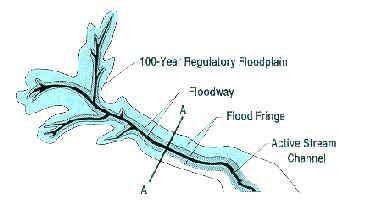This fact sheet is an overview of the Stormwater and Floodplain Management Ordinance and is not intended to be all inclusive or interpreted as regulation. Copies of the ordinance are available from the city's One Stop Shop and on the internet at municode.com. Contact Stormwater Management staff at 480-312-2500 regarding specific questions.
How does the Stormwater and Floodplain Management Ordinance protect my property?
The ordinance establishes requirements for the use and development of land that will minimize potential losses and hazardous conditions that might result from flooding. Additionally, it prohibits development that would create hazards to life or property by increasing the likelihood of flooding on either the property under development or any other property.
What are some of the main requirements of the ordinance?
Runoff from all storms should enter and exit from a piece of land after its development in substantially the same manner as under pre-development conditions.
- The 100-year floodplain of watercourses within the environmentally sensitive lands (ESL) area with a 100-year peak discharge rate of 50 cubic feet per second (cfs) or greater shall be dedicated to the city by a drainage easement and maintained in a natural state, unless a wash modification permit is obtained. Outside the ESL area, drainage and flood control easements are required for all watercourses with a 100-year peak discharge rate of 25 cfs or greater. These watercourses are not required to be maintained in their natural state.
- Generally, new development within the city must provide stormwater storage.
- Access must be provided for all lots within a development (from the property line of that development) during the peak flow of the 100-year flood. Access is considered to exist if the depth of flow over the road does not exceed one foot.
- Watercourses may not be altered unless a professional civil engineer certifies that the alterations will not increase flood levels or flooding hazards. The obstruction or reduction in capacity of a watercourse by any use or by filling, dumping, constructing, or any other means is prohibited.
How are watercourses classified?
The ESL Ordinance also classifies watercourses as major (more than 750 cfs) and minor (between 250 and 750 cfs) for planning purposes.
Are large developments such as master-planned communities subject to the same requirements as other developments?
Yes, by law any development, regardless of its size, within the city is required to adhere to the Stormwater and Floodplain Management ordinance.
The natural drainage pattern seems to work, why then are detention basins needed?
Storage basins are needed to offset the increase in runoff created by new development, so that flooding potential is not increased on downstream properties.
Can watercourses be altered?
The ordinance states "a watercourse may not be altered" unless a professional engineer certifies that the alterations do not increase the flood levels, and will not increase flood hazards within, upstream or downstream of the altered portion of the watercourse. Watercourses with a 100-year peak discharge rate of 50 cfs or greater within the ESL area cannot be altered since they are required to be maintained in their natural state, unless a wash modification permit is obtained. In order to qualify for a wash modification permit, an applicant must demonstrate hardship, minimizing disturbance, context-sensitive design, and re-vegetation plans, subject to the Zoning Administrator's approval.
Can I build in a wash?
This is generally discouraged, and is actually prohibited by ordinance in most situations. The ordinance also prohibits the obstruction of a watercourse or the reduction in the capacity of a watercourse.
Why can't the washes be left in their natural state?
They can be if property owners are willing to do so, and in some instances it is required by city ordinance. Within the ESL area, washes with a 100-year peak discharge rate of 50 cfs or greater are required to be maintained in their natural state, unless a wash modification permit is obtained. In other parts of the city and on smaller washes within the ESL area there are no requirements that a wash be kept natural, but flow capacity must be maintained. Washes and their floodplains when left in their natural state have many beneficial functions in addition to drainage and flood control characteristics. Aesthetics, wildlife habitat, recreation, water quality and groundwater recharge are a few examples of these natural and beneficial floodplain functions.
What is a floodplain?

PLAN VIEW OF FLOODPLAIN AND RIPARIAN HABITAT
Regulatory Floodplain (100-year Floodplain):
The channel and adjacent land areas inundated by the discharge from the flood having a 1% probability of being equaled or exceeded in any given year.
Floodway:
The channel and portions of the adjacent floodplain that must be kept free of encroachments so that the 100-year flood discharge (base flood) can be conveyed without raising the flood level.
Flood Fringe: The area inundated by the 100-year flood that is outside the floodway.
The area inundated by the 100-year flood that is outside the floodway.